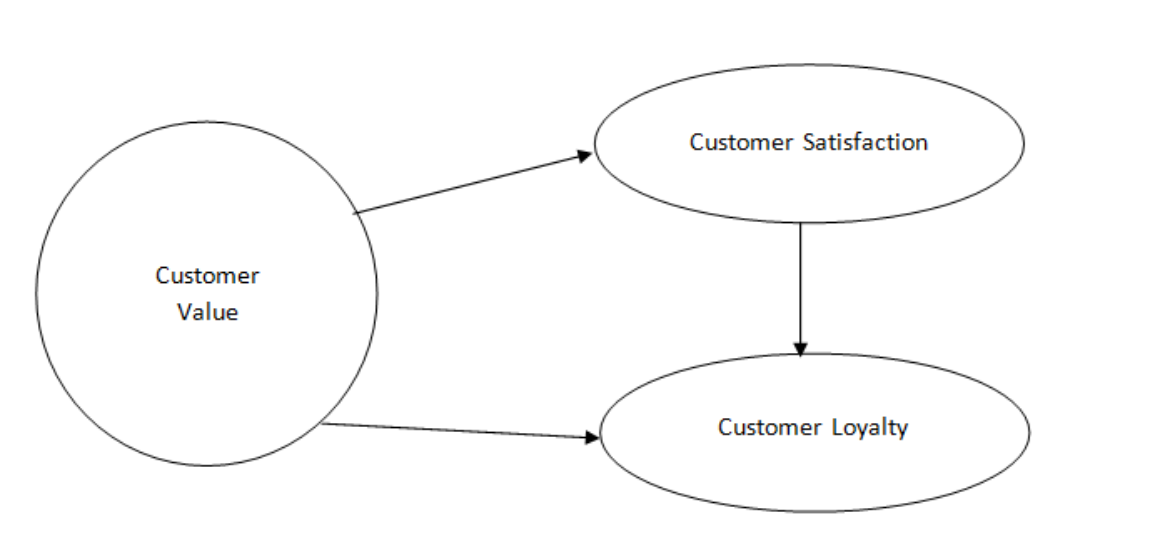Interdependence Between Customer Value Customer Satisfaction and Customer Loyalty
Relationship Between Customer Value Customer Satisfaction and Customer Loyalty
The emergence of relationship marketing as a leading paradigm in marketing shifted the focus from attracting customers retaining and taking proper care of the existing customer base. Since satisfying the customers is the only way of retaining them, marketers make every attempt to provide better customer value to their customers than their competitors. A better perception of value by customers can make them more satisfied regarding the products offered by the company. For example, customers of Sony who perceive higher value in Sony’s product feel more satisfied as they expect to receive more utility by buying Sony’s products. Services marketing literature argues that customer satisfaction is the result of the customer’s perception of value received. In an empirical study done by Hallowell (1996), it was proved that satisfaction of customers is dependent on perceived customer value. In another study done using a sample from luxury hotel industry by Oh (1999), it was found that perceived value has a direct positive impact on customer satisfaction and that customer value is an immediate antecedent to customer satisfaction and repurchase intentions.

Over the years, firms started focusing more on customer loyalty due to its impact on their profitability. Further, customer satisfaction and customer loyalty lie at the core of customer relationship management. Customers will keep buying a company’s products when the products’ actual performance meets their expectations. In other words, they will return to the company only when they are satisfied with the products’ performance. Customer satisfaction can thus influence the loyalty of customers to a company. Research on the association between customer satisfaction and loyalty proved a clear positive relationship between the two. In an individual-level model of customer loyalty tested in the context of retail banking sector by Rust and Zahorik (1993), it was established that customer satisfaction has a direct positive impact on customer loyalty. Companies with high customer satisfaction but which fail to make their customers loyal make lower profits than their true potential (Zhang et al. 2011). Maximizing the profits of a business is one of the key objectives of improving customer loyalty. Some of the tactics that can be employed to improve customer satisfaction and loyalty are listed as follows:
- sending thank-cards,
- rewarding customers who recommend your business to others,
- choosing the field in which they are the best,
- sending personal letters,
- preparing events and occasions peculiar to customer,
- reminding by phone,
- solving customer complaints quickly and giving faster replies.
While the relationship between customer value and customer loyalty is generally mediated by customer satisfaction, customer value can also directly impact customer loyalty. Despite the evidence to the fact that customer loyalty is a direct consequence of customer satisfaction, some researchers suggested that satisfying the customers may not be the only way of creating loyal customers. Conditions like financial conditions of customers, high switching costs, high risk perceptions, limitation on the time available with customers to search for alternatives, and personal characteristics of customers will directly lead to customer loyalty without customer satisfaction mediating in the middle (Mittal and Kamakura, 2001). In a study by Yang and Peterson (2004), it was empirically proved that customer value directly impacts customer loyalty when the switching costs between the products made by different companies is higher. In the context of services too, customer value controls “behavioral intentions of loyalty toward the service provider as long as such relational exchanges provide superior value” (Sirdeshmukh et al. 2002). The interdependence of the three constructs is given in the figure below.
Figure: Interdependence between Customer Value, Customer Satisfaction, and Customer Loyalty

Thus customer value, customer satisfaction, and customer loyalty all play an important role for companies in maintaining a profitable relationship with their customers. Customer loyalty depends on the satisfaction levels of consumers which may in turn depend on customer value.
Our professional essay writers are always here to help you. Academic Mentor Online is trusted by thousands of students from all over the world. Contact our support department to get the best quality academic writing help.
